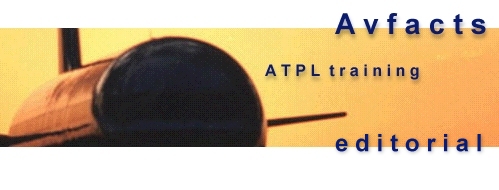| An important function of tyre/ground
friction is to produce cornering forces. Tyre cornering forces are the
primary means of controlling runway tracking on the ground-even on very
slippery runways. On slippery
runways a tyre develops its maximum cornering force at about 5 degrees
of yaw; beyond this point the sideforce decreases rapidly. A high vertical
load (i.e.: weight on the tyres) and no tyre skidding also increase the
cornering force available.
Whereas a certain amount of tyre rotational slip is necessary to
produce a braking force, that same slip reduces the tyre cornering force.
 |
Braking and skidding,
reduce tyre cornering force. A locked tyre produces no cornering
force at all, so spinning up all the tyres as they touchdown is
essential to maintain runway tracking capability. |
|
|
 |
As the pilot you can
NOT change the available friction on the runway, but you can
increase the vertical load on the tyres by lowering the nose, which
will reduce lift. Promptly lowering the nosewheel onto the runway
will also greatly increase the patch area available for cornering,
and will assist in keeping the aircraft straight. |
|
|
 |
If a side slide should
develop, release the brakes momentarily. This will increase the
cornering force of the tyres and get the aircraft straightened up
quickly. Do NOT stay on the brakes ! Side slides can occur when
there is significant cross winds. These not only blow the aircraft
onto the downwind side of the runway, but also
weathercock the aircraft so that the nose swings into wind (i.e.:
pointing back toward the runway centre). |
|
|
Improving runway surface
- Some runways have a very noticeable camber. This allows any water
present to flow off the runway. Roads also have a marked camber (ie:
rise up from gutter to the centreline), for this purpose.
- Some runways are porous, and/or have grooves running across them.
Both features assist in clearing water off the runway, and the
grooves also help in keeping the tyre rotating.
Summary
- Smooth, flat runways with poor drainage, rubber deposits and
painted surface markings are the worst.
- Runways that are porous, grooved and have a marked crest toward
the centreline are best.
- Do NOT attempt a “greaser” landing on a runway with
significant water on it.
- Lower the nosewheel as soon as possible after the main wheels
touch down.
- Use thrust reverse if available. Spoilers and reverse thrust
together contribute about 70% of the total braking action during the
high speed portion of the landing roll on a slippery runway. They
are less effective at low speed, where wheel braking effort has a
greater contribution to total deceleration.
- Ensure the speed is safe before turning off the runway.
- Remember that greatest tyre cornering effort occurs when braking
is NOT used.
- On slippery runways, antiskid or individual brake failures may
limit the takeoff weight, due to the reduced braking effort
available should an abort be required.
- Tyre condition is important. Carefully inspect the tyres for tread
depth, cuts and flat spots.
- Avoid landing too far into a slippery runway. Remember runway
behind you is of no use to you.
I hope this mini-editorial assists you.
Happy flying !
Rob Avery
ATPL Lecturer

Marty says ... "Goodbye to GA".
|










![]()